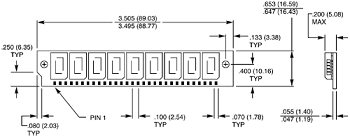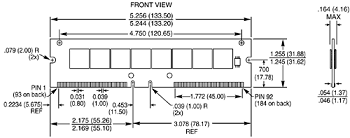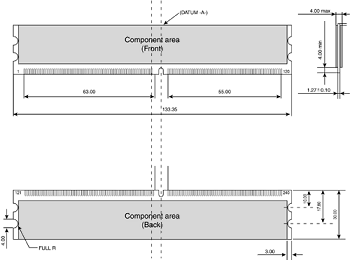SIMMs, DIMMs, and RIMMs
Originally, systems had memory installed via individual chips. They are often referred to as dual inline package (DIP) chips because of their designs. The original IBM XT and AT had 36 sockets on the motherboard for these individual chips; then more of them were installed on the memory cards plugged into the bus slots.
Besides being a time-consuming and labor-intensive way to deal with memory, DIP chips had one notorious problem—they crept out of their sockets over time as the system went through thermal cycles. Every day, when you powered the system on and off, the system heated and cooled, and the chips gradually walked their way out of the sockets.
Eventually, good contact was lost and memory errors resulted. Fortunately, reseating all the chips back in their sockets usually rectified the problem, but that method was labor intensive if you had a lot of systems to support.
The alternative to this at the time was to have the memory soldered into either the motherboard or an expansion card. This prevented the chips from creeping and made the connections more permanent, but it caused another problem.
If a chip did go bad, you had to attempt desoldering the old one and resoldering a new one or resort to scrapping the motherboard or memory card on which the chip was installed. This was expensive and made memory troubleshooting difficult.
A chip was needed that was both soldered and removable, and that is exactly what was found in the module called a SIMM. For memory storage, most modern systems have adopted the single inline memory module (SIMM), DIMM, or RIMM as an alternative to individual memory chips.
These small boards plug into special connectors on a motherboard or memory card. The individual memory chips are soldered to the module, so removing and replacing them is impossible. Instead, you must replace the entire module if any part of it fails. The module is treated as though it were one large memory chip.
Two main types of SIMMs, three main types of DIMMs, and so far one type of RIMM are used in desktop systems. The various types are often described by their pin count, memory row width, or memory type.
SIMMs, for example, are available in two main physical types—30-pin (8 bits plus an option for 1 additional parity bit) and 72-pin (32 bits plus an option for 4 additional parity bits)—with various capacities and other specifications.
The 30-pin SIMMs are physically smaller than the 72-pin versions, and either version can have chips on one or both sides. SIMMs were widely used from the late 1980s to the late 1990s but have become obsolete.
DIMMs are also available in three main types. DIMMs usually hold standard SDRAM or DDR SDRAM chips and are distinguished by different physical characteristics. Standard DIMMs have 168 pins, one notch on either side, and two notches along the contact area.
DDR DIMMs, on the other hand, have 184 pins, two notches on each side, and only one offset notch along the contact area. DDR2 DIMMs have 240 pins, two notches on each side, and one in the center of the contact area. All DIMMs are either 64-bits (non-ECC/parity) or 72-bits (parity or error correcting code [ECC]) wide (data paths).
The main physical difference between SIMMs and DIMMs is that DIMMs have different signal pins on each side of the module. That is why they are called dual inline memory modules, and why with only 1'' of additional length, they have many more pins than a SIMM.
RIMMs also have different signal pins on each side. Three different physical types of RIMMs are available: a 16/18-bit version with 184 pins, a 32/36-bit version with 232 pins, and a 64/72-bit version with 326 pins. Each of these plugs into the same sized connector, but the notches in the connectors and RIMMs are different to prevent a mismatch.
A given board will accept only one type. By far the most common type is the 16/18-bit version. The 32-bit version was introduced in late 2002, and the 64-bit version won't be introduced until 2004.
The standard 16/18-bit RIMM has 184 pins, one notch on either side, and two notches centrally located in the contact area. 16-bit versions are used for non-ECC applications, whereas the 18-bit versions incorporate the additional bits necessary for ECC.
Figures 1–3 show a typical 30-pin (8-bit) SIMM, 72-pin (32-bit) SIMM, 168-pin SDRAM DIMM, 184-pin DDR SDRAM (64-bit) DIMM, 240-pin DDR2 DIMM, and 184-pin RIMM, respectively.



The pins are numbered from left to right and are connected through to both sides of the module on the SIMMs. The pins on the DIMM are different on each side, but on a SIMM, each side is the same as the other and the connections carry through.
Note that all dimensions are in both inches and millimeters (in parentheses), and modules are generally available in error correcting code (ECC) versions with 1 extra ECC (or parity) bit for every 8 data bits (multiples of 9 in data width) or versions that do not include ECC support (multiples of 8 in data width).
All these memory modules are fairly compact considering the amount of memory they hold and are available in several capacities and speeds.
SIMMs, DIMMs, DDR DIMMs, and RIMMs of each type and capacity are available in various speed ratings. Consult your motherboard documentation for the correct memory speed and type for your system. It is usually best for the memory speed (also called throughput or bandwidth) to match the speed of the processor data bus (also called the front side bus or FSB).
If a system requires a specific speed, you can almost always substitute faster speeds if the one specified is not available. Generally, no problems occur in mixing module speeds, as long as you use modules equal to or faster than what the system requires.
Because there's little price difference between the various speed versions, I often buy faster modules than are necessary for a particular application. This might make them more usable in a future system that could require the faster speed.
Because DIMMs and RIMMs have an onboard ROM that reports their speed and timing parameters to the system, most systems run the memory controller and memory bus at the speed matching the slowest DIMM/RIMM installed.
Most DIMMs are SDRAM memory, which means they deliver data in very high-speed bursts using a clocked interface. DDR DIMMs are also SDRAM, but they transfer data two times per clock cycle and thus are twice as fast. You can't always replace a module with a higher-capacity unit and expect it to work.
Systems might have specific design limitations for the maximum capacity of module they can take. A larger-capacity module works only if the motherboard is designed to accept it in the first place. Consult your system documentation to determine the correct capacity and speed to use.
Registered Modules
SDRAM and DDR DIMMs are available in buffered, unbuffered, and registered versions. A buffered module has additional buffer circuits between the memory chips and the connector to condition or buffer the signals. Virtually all PC motherboards designed to use SDRAM or DDR require unbuffered or registered modules instead.
In fact, no PCs that I am aware of use plain buffered modules. Some of the early PowerPC Macs might have used buffered SDRAM, but no PCs do. Because so few systems ever used them, you will not find buffered modules available for sale.
Most PC motherboards are designed to use unbuffered modules, which allow the memory controller signals to pass directly to the memory chips on the module with no interference. This is not only the cheapest design, but also the fastest and most efficient.
The only drawback is that the motherboard designer must place limits on how many modules (meaning module sockets) can be installed on the board, and possibly also limit how many chips can be on a module. So-called double-sided modules that really have two banks of chips (twice as many as normal) onboard might be restricted on some systems in certain combinations.
Systems designed to accept extremely large amounts of RAM often require registered modules. A registered module uses an architecture which has register chips on the module that act as an interface between the actual RAM chips and the chipset.
The registers temporarily hold data passing to and from the memory chips and enable many more RAM chips to be driven or otherwise placed on the module than the chipset could normally support. This allows for motherboard designs that can support many modules and enables each module to have a larger number of chips.
In general, registered modules are required by server or workstation motherboards designed to support more than 1GB or 2GB of RAM. The important thing to note is that you can use only the type of module your motherboard (or chipset) is designed to support. For most, that is standard unbuffered modules or, in some cases, registered modules.